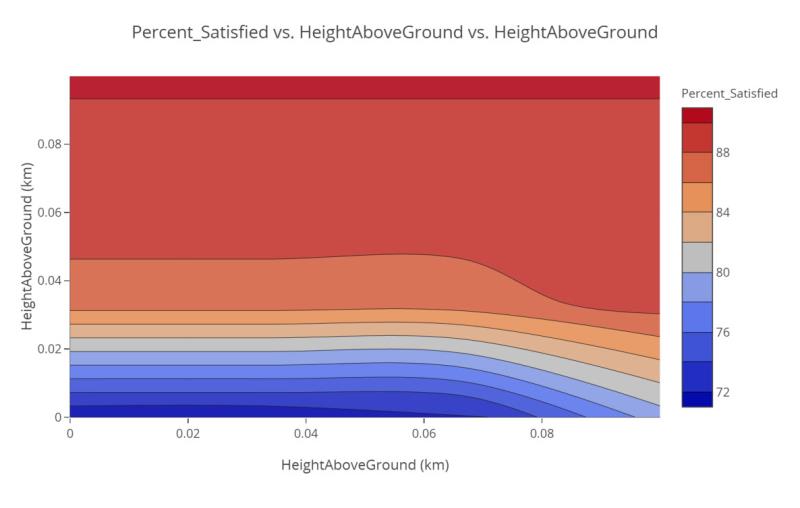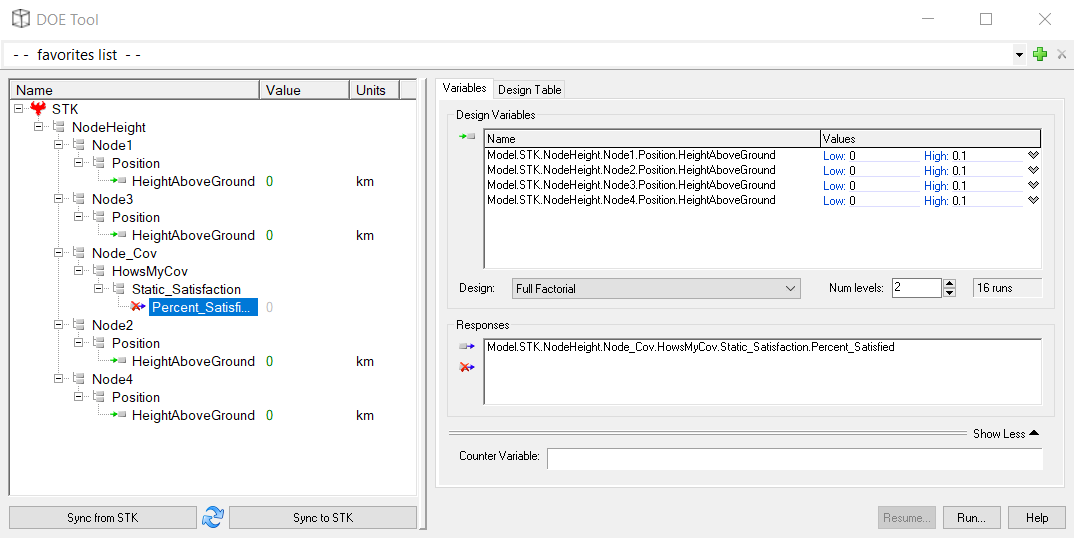STK Premium (Air), STK Premium (Space), or STK Enterprise
You can obtain the necessary licenses for this tutorial by contacting AGI Support at support@agi.com or 1-800-924-7244.
Required product install: A 64-bit version of Java is required to run Analyzer. See the Analyzer system requirements for more information.
The results of the tutorial may vary depending on the user settings and data enabled (online operations, terrain server, dynamic Earth data, etc.). It is acceptable to have different results.
Capabilities Covered
This lesson covers the following capabilities:
- STK Pro
- STK Analyzer
- Coverage
- Communications
Video Guidance
Watch the following video. Then follow the steps below, which incorporate the systems and missions you work on (sample inputs provided).Please note, the video refers to a starter scenario accessed from the STK Data Federate (SDF). This scenario is included with your STK install. Please follow the written steps in this tutorial to open the file.
Analyzer
STK's Analyzer capability is integrated into the STK workflow to help you automate and analyze STK trade studies to better understand the design of your system.
Using Analyzer, Scenario parameters can be systematically modified to learn more about your Scenario. For purposes of this tutorial, Analyzer will be used to:
- Perform Trade Studies. Analyzer will allow you to quickly perform “what if” studies so that you can understand how changing various Scenario parameters will impact the Scenario.
- Optimize Scenario Parameters. Once you understand the key parameters of a Scenario, an optimizer will be employed to drive the Scenario to an optimal configuration.
For more information on Analyzer, see www.agi.com.
Tutorial
In this tutorial, you will do the following:
- Analyze a STK Scenario for trends.
- Use the Design of Experiments tool
This tutorial is designed to teach you how to use Analyzer’s Design of Experiments tool to vary two or more parameters in your scenario and observe the impact on an output.
Using a starter scenario
To speed things up and have you to focus on the portion of this exercise that teaches you Analyzer, a partially created scenario has been provided for you.
Loading the starter scenario
The STK scenario (VDF) used with this tutorial is included with the STK installation. To open the scenario:
- Launch the STK® (
 ) application.
) application. - Click in the Welcome to STK dialog.
- Select Installed Scenarios in the navigation pane or browse to <STK install folder>\Data\ExampleScenarios.
Opening the VDF
- Select NodeHeight.vdf.
- Click .

Saving the starter scenario as an SC file
When you open the scenario, the STK application will create a folder with the same name as the scenario in the default user folder (C:\Users\<username>\Documents\STK_ODTK 13, for example). The STK application will not save the scenario automatically. When you choose save a scenario, the STK application will default to saving it in the format in which it originated. Therefore, if you open a VDF, the default save format will be a VDF. The same is true for a scenario file (*.sc). To save the VDF as an SC file, change the file format using the Save As procedure:
- Open the File menu.
- Select Save As....
- Select the STK User folder in the navigation pane when the Save As dialog box opens.
- Select the folder with the same name as the scenario.
- Click .
- Select Scenario Files (*.sc) in the Save as type drop-down list.
- Select the Scenario file in the file browser.
- Click .
- Click in the Confirm Save As Dialog box to overwrite the existing scenario file in the folder and to save your scenario.
A scenario folder with the same name as the VDF was created for you when you opened the VDF in the STK application. This folder contains the temporarily unpacked files from the VDF.
Project: Communication Nodes
The goal of this project is to study the impact of terrain on a communications link to a vehicle traveling on a road through the mountains. There are four proposed locations for communication nodes that would be used as relays to a satellite and finally to a receiving station. We would like to assess the impact of antenna height on the ability to communicate with a vehicle on the road.
We will first create a carpet plot to see the impact of changing two antennas at a time. We will then use the design of experiments tool to vary the height of all four antennas at the same time so that we can find the best possible configuration for all the antennas.
Exercise 1. Compute Coverage Statistics
We will use Analyzer to perform studies on the Percent Satisfied report for a Figure of Merit. To understand this report, data will first be manually collected in STK.
- Compute accesses for the Node_Cov coverage area.
- Right-click on Node_Cov (
 ) in the Object Browser.
) in the Object Browser. - Expand CoverageDefinition in the context menu.
- Select Compute Accesses.
- Right-click on Node_Cov (
- Generate a Percent Satisfied report in STK.
- Right-click on the HowsMyCov Figure of Merit (FOM) (
 ) under the Node_Cov object in the Object Browser.
) under the Node_Cov object in the Object Browser. - Select the Report and Graph Manager... menu item.
- Expand the Installed Styles folder.
- Select Percent Satisfied report.
- Click .
- Right-click on the HowsMyCov Figure of Merit (FOM) (

In the resulting report, note the % Satisfied value. This value will be accessible in Analyzer as an output variable.
Exercise 2. Open Analyzer
- Click View on the Menu bar.
- Extend the Toolbars menu.
- Select Analyzer. This will bring up the Analyzer toolbar.

- Click on the Analyzer icon (
 ) to bring up the main Analyzer window. This is where input and output variables of the scenario may be selected to analyze.
) to bring up the main Analyzer window. This is where input and output variables of the scenario may be selected to analyze.
Exercise 3. Assess the Impact of Changing Two Antenna Heights
We will first run a carpet plot to analyze the impact of raising the height of two of the antennas. We could choose any pair of antennas we would like. For this study, we will look at Node1 and Node3.
From the Analyzer main form, we will add input and output Analyzer variables.
- Select the input Analyzer variables for this trade study.
- In the STK Variables list, select Node1.
- In the STK Property Variables field, extend Position.
- Click and drag HeightAboveGround to the Analyzer Variables section. It will show up under the Inputs list.
- Repeat the steps above to move Node3 HeightAboveGround to the Analyzer Variables Inputs section as well.
- Select the output Analyzer variables for this trade study.
- In the STK Variables list, expand Node_Cov, and select the HowsMyCov FOM.
- In the Data Provider Variables section, expand Static Satisfaction.
- Click and drag Percent Satisfied to the Analyzer Variables section. It will show up under the Outputs list.
- In the Analyzer window, click on the Carpet Plot icon (
 ) to open a new Carpet Plot study.
) to open a new Carpet Plot study. - Fill in the Design Variables (input variables):
- Under Node1 > Position, click and drag HeightAboveGround to the input field on the right.
- Under Node3 > Position, click and drag HeightAboveGround to the input field on the right.
- Set the following values for both inputs:
Option Value From: 0 To: 0.1 number of samples: 4 step size: 0.03333 - Fill in the Responses (output variables):
- Click on Percent_Satisfied in the Component Tree on the left.
- Drag it to the Responses field on the right.
- The Carpet Plot study should look like this:
- Perform the carpet plot by clicking the button. Note that no plots will appear for this study until all data points have been collected.
- Now create a Contour Plot.
- On the Carpet Plot window, click Add View.
- Select the Contour Plot.
The new plot is shown below.

- Close all data display pages.


Once the trade study is complete and all data has been collected, the Carpet Plot displays.

There are multiple views that can be selected to visualize the data seen on the Table Page. You can choose views by clicking on Add View. You can build custom views or switch to Legacy Views.
The Carpet and Contour Plots indicate that changing Node3’s height has a much greater impact on the percent of the road covered than Node1.
The Carpet Plot gives a valuable way to visually analyze the impact of two variables on coverage capabilities. However, we would still like to see the impact of varying the height of all of the nodes. The Design of Experiments tool will allow us to do this.
Exercise 4. Vary All Four Antenna Heights Using Design of Experiments
We’ve seen the impact of varying two antenna heights. The carpet plot showed that varying Node1’s height had less impact on coverage time than varying Node3’s height. By using the Design of Experiments tool, we’ll be able to see how each of the nodes impact coverage time.
- On the Analyzer main form, add HeightAboveGround for Node2 and Node4.
- In the STK Variables list, select Node2.
- In the STK Property Variables field, extend Position.
- Click and drag HeightAboveGround to the Analyzer Variables section. It will show up under the Inputs list.
- Repeat the steps above to move Node4 HeightAboveGround to the Analyzer Variables Inputs section as well.
- Click the Design of Experiments (DOE) icon (
 ) on the Analyzer toolbar.
) on the Analyzer toolbar. - Fill in the Design Variables (input variables):
- Under Node1 > Position, click and drag HeightAboveGround to the input field on the right.
- Repeat the step above for Node2, Node3, and Node4.
- Set the following values for all four Design Variables Values:
Option Value Low: 0 High: 0.1 - Fill in the Responses (output variables):
- Click on Percent_Satisfied in the Component Tree on the left.
- Drag it to the Responses field on the right.
- The DOE Tool should look like this:
- Perform the study by clicking .
-
Now create a Variable Importance Summary Plot.
- On the Data Explorer page, expand Add View.
- Select the Variable Importance Summary Plot.
The new plot is shown below.



After examining the table of results, we can see that the best possible coverage percentage is ~95%. It is interesting to note that this amount of coverage can be achieved with only two antennas raised to 100 m. This occurs with the combination of Node1 and Node2 as well as the combination of Node2 and Node3, each raised to 100 m.